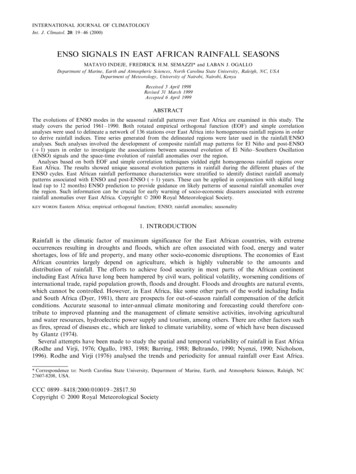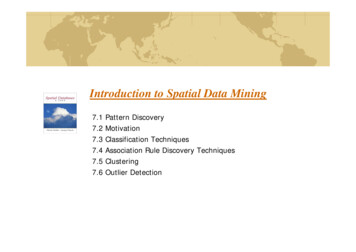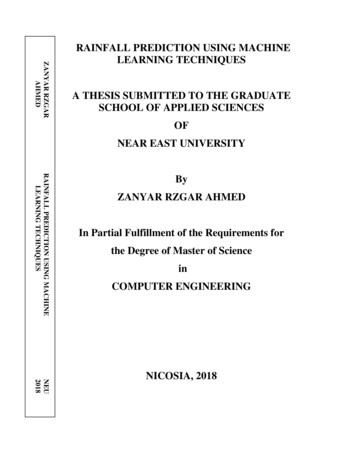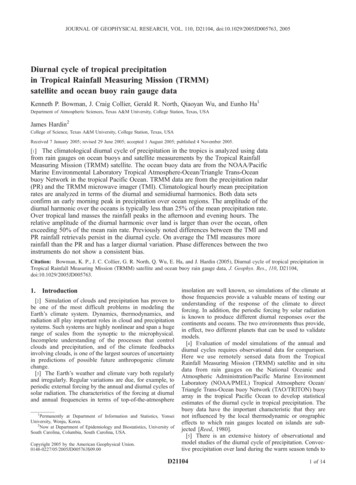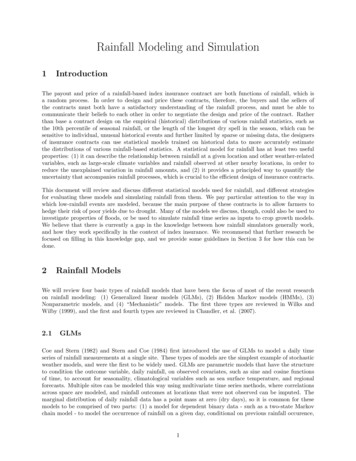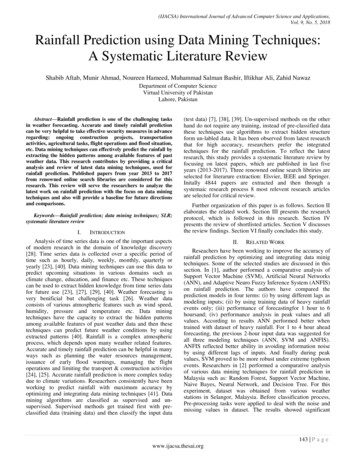
Transcription
(IJACSA) International Journal of Advanced Computer Science and Applications,Vol. 9, No. 5, 2018Rainfall Prediction using Data Mining Techniques:A Systematic Literature ReviewShabib Aftab, Munir Ahmad, Noureen Hameed, Muhammad Salman Bashir, Iftikhar Ali, Zahid NawazDepartment of Computer ScienceVirtual University of PakistanLahore, PakistanAbstract—Rainfall prediction is one of the challenging tasksin weather forecasting. Accurate and timely rainfall predictioncan be very helpful to take effective security measures in advanceregarding: ongoing construction projects, transportationactivities, agricultural tasks, flight operations and flood situation,etc. Data mining techniques can effectively predict the rainfall byextracting the hidden patterns among available features of pastweather data. This research contributes by providing a criticalanalysis and review of latest data mining techniques, used forrainfall prediction. Published papers from year 2013 to 2017from renowned online search libraries are considered for thisresearch. This review will serve the researchers to analyze thelatest work on rainfall prediction with the focus on data miningtechniques and also will provide a baseline for future directionsand comparisons.Keywords—Rainfall prediction; data mining techniques; SLR;systematic literature reviewI.INTRODUCTIONAnalysis of time series data is one of the important aspectsof modern research in the domain of knowledge discovery[28]. Time series data is collected over a specific period oftime such as hourly, daily, weekly, monthly, quarterly oryearly [23], [40]. Data mining techniques can use this data topredict upcoming situations in various domains such asclimate change, education, and finance etc. These techniquescan be used to extract hidden knowledge from time series datafor future use [23], [27], [29], [40]. Weather forecasting isvery benificial but challenging task [26]. Weather dataconsists of various atmospheric features such as wind speed,humidity, pressure and temperature etc. Data miningtechniques have the capacity to extract the hidden patternsamong available features of past weather data and then thesetechniques can predict future weather conditions by usingextracted patterns [40]. Rainfall is a complex atmosphericprocess, which depends upon many weather related features.Accurate and timely rainfall prediction can be helpful in manyways such as planning the water resources management,issuance of early flood warnings, managing the flightoperations and limiting the transport & construction activities[24], [25]. Accurate rainfall prediction is more complex todaydue to climate variations. Reseacrhers consistently have beenworking to predict rainfall with maximum accuracy byoptimizing and integrating data mining techniques [41]. Datamining algorithms are classified as supervised and unsupervised. Supervised methods get trained first with preclassified data (training data) and then classify the input data(test data) [7], [38], [39]. Un-supervised methods on the otherhand do not require any training, instead of pre-classified datathese techniques use algorithms to extract hidden structureform un-labled data. It has been observed from latest researchthat for high accuracy, researchers prefer the integratedtechniques for the rainfall prediction. To reflect the latestresearch, this study provides a systematic literature review byfocusing on latest papers, which are published in last fiveyears (2013-2017). Three renowned online search libriries areselected for literarure extraction: Elsvier, IEEE and Springer.Initally 4844 papers are extracted and then through asystemaic research process 8 most relevent research articlesare selected for critical review.Further organization of this paper is as follows. Section IIelaborates the related work. Section III presents the researchprotocol, which is followed in this research. Section IVpresents the review of shortlisted articles. Section V discussesthe review findings. Section VI finally concludes this study.II.RELATED WORKReseachers have been working to improve the accuracy ofrainfall prediction by optimizing and integrating data minigtechniques. Some of the selected studies are discussed in thissection. In [1], author performed a comparative analysis ofSupport Vector Machine (SVM), Artificial Neural Networks(ANN), and Adaptive Neuro Fuzzy Inference System (ANFIS)on rainfall prediction. The authors have compared theprediction models in four terms: (i) by using different lags asmodeling inputs; (ii) by using training data of heavy rainfallevents only; (iii) performance of forecastingfor 1 hour to 6hoursand; (iv) performance analysis in peak values and allvalues. According to results ANN performed better whentrained with dataset of heavy rainfall. For 1 to 4 hour aheadforecasting, the previous 2-hour input data was suggested forall three modeling techniques (ANN, SVM and ANFIS).ANFIS reflected better ability in avoiding information noiseby using different lags of inputs. And finally during peakvalues, SVM proved to be more robust under extreme typhoonevents. Researchers in [2] performed a comparative analysisof various data mining techniques for rainfall prediction inMalaysia such as: Random Forest, Support Vector Machine,Naive Bayes, Neural Network, and Decision Tree. For thisexperiment, dataset was obtained from various weatherstations in Selangor, Malaysia. Before classification process,Pre-processing tasks were applied to deal with the noise andmissing values in dataset. The results showed significant143 P a g ewww.ijacsa.thesai.org
(IJACSA) International Journal of Advanced Computer Science and Applications,Vol. 9, No. 5, 2018performance of Random Forest as it correctly classified largeamount of instances with small amount of training data. In [3],author performed a survey on various Neural Networkarchitectures which were used for rainfall prediction in last 25years. The authors highlighted that most of the researchers gotsignificant results in rainfall prediction by using PropagationNetwork, moreover the forecasting techniques which usedSVM, MLP, BPN, RBFN, and SOM are more suitable thanother statistical and numerical techniques. Some limitationshave also been highlighted. Researchers in [4] used ArtificialNeural Network for rainfall prediction in Thailand. They usedBack Propagation Neural Network for prediction whichreported an acceptable accuracy. For future direction it wassuggested that few additional features would be included ininput data for rainfall prediction such as Sea SurfaceTemperature for the areas around Andhra Pradesh andSouthern part of India. Researchers in [5] predicted monthlyrainfall by using Back Propagation, Radial Basis Function andNeural Network. For prediction, the dataset was collectedfrom Coonoor region in Nilgiri district (Tamil Nadu).Performance was evaluated in terms of Mean Square Error.According to results higher accuracy was reported in RadialBasis Function Neural Network with smaller Mean SquareError. Moreover the researchers also used these techniques forfuture rainfall prediction. Researchers in [6] presented aHybrid Intelligent System by integrating Artificial NeuralNetwork and Genetic Algorithm. In ANN, MLP works as theData Mining engine to perform predictions whereas theGenetic Algorithm was utilized for inputs, the connectionstructure between the inputs, the output layers and to make thetraining of Neural Network more effective. Researchers in [8]discussed rainfall pace in previous years with respect tovarious crops seasons like rabi, Kharif, zaid and then predicted(rainfall) for future seasons via Linear Regression Method.For prediction, input dataset was selected according toparticular corps seasons of previous years. In [9], one monthand two month forecasting models were developed for rainfallprediction by using Artificial Neural Network (ANN). Theinput dataset was selected from multiple stations in NorthIndia, spanned on past 141 years. Feed Forward NeuralNetwork using Back Propagation and Levenberg-Marquardttraining function were used in these models. Performance ofboth models was evaluated by using Regression Analysis,Mean Square Error and Magnitude of Relative Error. Theresults showed that one month forecasting model can predictthe rainfall more accurately than two month forecastingmodel. Researchers in [10] presented an algorithm byintegrating Data Mining and Statistical Techniques. Theproposed technique predicted the rainfall in five differentcategories such as: Flood, Excess, Normal, Deficit andDrought. The predictors were selected with highest confidencelevel, based on association rules and derived from local andglobal environment. From local environment: wind speed, sealevel pressure, maximum temperature, and minimumtemperature were taken. From global environment: Indianocean dipole conditions and southern oscillation were taken.In [11], researchers predicted the rainfall by usingproposed Wavelet Neural Network Model (WNN), anintegration of Wavelet Technique and Artificial NeuralNetwork (ANN). To analyze the performance, monthlyrainfall prediction was performed with both the techniques(WNN and ANN) by using dataset of Darjeeling rain gaugestation in India. Statistical techniques were used forperformance evaluation and according to results WNNperformed better than ANN. In [12], researchers provided adetailed survey and performed a comparative analysis ofvarious neural networks on rainfall forecasting. According tosurvey RNN, FFNN, and TDNN are suitable for rainfallprediction as compared to other statistical and numericalforecasting methods. Moreover TDNN, FFNN and lag FFNNperformed well for yearly, monthly and weekly rainfallforecasting respectively. This research also discussed thevarious measures of accuracy used by different researchers toevaluate the ANN's performance.III.RESEARCH PROTOCOLHigh quality SLR is one which attains its objective byproviding the compact information of required research topicfor a particular time span. A detailed research methodologywith step by step guidance is needed to conduct an effectiveSLR. In this research a systematic research process isformulated by following the guidelines extracted from [13][18]. Usually SLR consists of three basic steps: plan review,conduct review and document review moreover further nestedsteps can be included from modern and state of the artresearch papers for an effective presentation. For this study, astep by step systematic review process is extracted from thelatest review articles of software engineering domains [19][22]. The systematic review process of this research consistsof the following steps: A) Identification of research questions,B) Keywords selection for query string, C) Selection of searchspace, D) Outlining the selection criteria, E) Literatureextraction, F) Quality assessment, G) Literature Analysis andH) Results and Discussion (Fig. 1).A. Identification of Research QuestionsResearch objectives are identified and presented in theform of research questions. The ultimate purpose of SLR is tofind the answers of those questions via critical review.Flowing are the research questions identified for this research.RQ1: Which data mining techniques are used / proposed forrainfall prediction?RQ2: How the performance of prediction techniques isevaluated?RQ3: Which type of data is used for prediction?RQ4: For which location the rainfall prediction is performed?RQ5: Which factors affect the prediction results?RQ6: Which are the latest research trends in the domain ofrainfall prediction?144 P a g ewww.ijacsa.thesai.org
(IJACSA) International Journal of Advanced Computer Science and Applications,Vol. 9, No. 5, 2018Three well known and widely used online libraries areselected to extract the literature: IEEE, Elsevier and Springer.All three libraries have different options to search the relevantmaterial, so few adjustments were made in query strings toextract the appropriate and most relevant literature. The Querywas searched multiple times with various combinations ofkey-words. Results of search queries are available in Table I.TABLE I.SEARCH SPACE AND QUERY RESULTSSr. #Digital LibraryDate SearchedTotal Springer2018-24-021906D. Outlining the Selection CriteriaThis step aims to outline the selection boundary so thatmost relevant research papers can be selected. This activityconsists of two steps, IC (inclusion criteria) and EC (exclusioncriteria).1) Inclusion CriteriaBelow are the rules of Inclusion criteria.IC1: Papers which are published from 2013 till 2017.IC2: Papers which are available in journals, conferences,proceedings of conferences or workshops.IC3: Papers which have predicted the rainfall using datamining techniques.IC4: Papers which have performed comparison of datamining techniques on rainfall prediction.IC5: Papers which have presented improvedcustomized data mining techniques to predict rainfall.orIC6: Papers which have integrated data mining techniquewith any other technique.Fig. 1. SLR process.B. Keywords Selection for Query StringSecond step is to formulate the query string and for thatpurpose, keywords are extracted first from the researchquestions and then arranged in a particular sequence to form aquery. Following keywords are extracted for query:Improved, Customized, Integrated, Data Mining,Techniques, Methods, Algorithms, Rainfall, uation,Assessment.The finalized query string is given below:(“Performance” AND (“Evaluation” OR “Assessment”) AND/ OR (“Improved” OR “Customized” OR “Integrated”) AND(“Data Mining”) AND (“Techniques” OR “Methods” OR“Algorithms”) AND “Rainfall” AND (“Prediction” OR“Forecasting” OR “Estimation”)).C. Selection of Search SpaceThis step deals with the selection of libraries from wherethe related literature will be extracted through query string.2) Exclusion Criteria (EC)Below are the rules of exclusion criteria.EC1: Papers which are not in English.EC2: Papers published before 2013 or after 2017.EC3: Papers which did not perform rainfall prediction.EC4: Paper which did not use any data mining techniquein proposed model/method?EC5: Paper which did not use any weather data forprediction.EC6: Papers which did not evaluate the performance ofused/proposed technique.E. Literature ExtractionThe purpose of selection criteria is to extract the mostrelevant literature for the review. After applying IC and EC,18 articles were shortlisted. Complete process of literatureextraction is given in Fig. 2.145 P a g ewww.ijacsa.thesai.org
(IJACSA) International Journal of Advanced Computer Science and Applications,Vol. 9, No. 5, 2018Fig. 2. Search process.F. Quality AssessmentTo meet the research objectives, it was make sure tofollow the quality parameters throughout the systematicresearch process. To ensure the quality of results, followingmeasures were taken. Authentic and renowned online libraries were selectedto extract research articles. Latest research papers were selected to reflect latestresearch. The process of selection was un-biased. Complete steps of Systematic Research Process werefollowed in the true sense.IV.LITERATURE ANALYSISFull text of 18 selected articles were analyzed and then 8most relevant research papers are shortlisted for critical reviewas shown in Table II. The Review of shortlisted articles isgiven below.TABLE II.MOST RELEVENT RESEARCH LITERATURESr. #Digital LibrarySelected ResearchLiteratureNo. of 5]-[37]3A. Indian Summer Monsoon Rainfall (ISMR) Forecastingusing Time Series Data: A Fuzzy-Entropy-Neuro basedExpert SystemIn [30], authors presented a model to forecast IndianSummer Monsoon Rainfall on the basis of monthly andseasonal timescales. To forecast, time series dataset was used,spanning from 1871 till 2014. The dataset was classified intwo parts (1) 1871-1960 used as training data, and (2) 19612014 used as test data. Statistical analysis reported thedynamic nature of rainfall in monsoon, which could not bepredicted effectively with mathematical and statistical models.So, the authors in this research recommended to use threetechniques for this type of prediction: Fuzzy Set, Entropy andArtificial Neural Network. By using these three techniques, aforecasting model is developed to deal with the dynamicnature of the ISMR. In proposed model, fuzzy set theory isused to handle uncertainties which are inherited in dataset.The entropy computational concept was modified in thismodel and used to provide the input as a degree ofmembership in the entropy function. That entropy functionwas referred as Fuzzy Information-Gain (FIG). Then, eachfuzzified rule was defuzzified using the ANN. The value ofFIG of each fuzzy- set was then used as input into ANN. Theproposed model was named as “Fuzzy-Entropy-Neuro BasedExpert System for ISMR Forecasting” because it is theintegration of fuzzy set, entropy and ANN. To evaluate theperformance of proposed model following accuracy measureswere used: Standard Deviations (SDs), Correlation Coefficient(CC), Root Mean Square Error (RMSE) and PerformanceParameter (PP). According to results the proposed model iseffective and efficient in comparison with other existingmodels.B. An Extensive Evaluation of Seven Machine LearningMethods for Rainfall Prediction in Weather DerivativesThe researchers in [31] compared the predictiveperformance of latest and state of the art method named“Markov chain extended with rainfall prediction” with theother widely used machine learning techniques: SupportVector Regression, Genetic Programming, M5 Rules, M5Model trees, Radial Basis Neural Networks, and k-NearestNeighbours. Daily rainfall datasets were collected from 42cities of two continents, with very diverse climatic features. 20cities were selected from around the Europe and 22 fromaround the USA. There were two reasons of choosing twocontinents for data extraction, first is to perform theexperiment on different climates having diverse weather andsecond was the geographical locations as the selected citieswere very far apart from each other. The ultimate goal was tonot bias the experiment to particular climate type or forparticular geographic location. According to results theaccumulating rainfall amounts can bring good results ascompared to prediction using daily rainy data. While using theaccumulated data, Support Vector Regression, Radial BasisFunctions, and Genetic Programming overall performed wellhowever Radial Basis Functions performed better then moderntechnique of “Markov chain”. For all selected datasets, eachtechnique used the same parameters so it was not guaranteedthat the best possible set of parameters was used for all thetechniques. During the experiment, the researchers have noted146 P a g ewww.ijacsa.thesai.org
(IJACSA) International Journal of Advanced Computer Science and Applications,Vol. 9, No. 5, 2018a relationship between predictive accuracy and climaticattributes such as: volatile nature of rainfall, amount ofmaximum rainfall and the interquartile range of rainfall.Moreover no significant difference was noted in algorithms’prediction error among the cities of both the continents (USAand Europe). Issue regarding the discontinuity in rainfall datawas solved with the help of accumulated rainfall amounts.C. A Hybrid Model for Statistical Downscaling of DailyRainfallAuthors in [32] proposed a hybrid technique to downscalethe daily rainfall by integrating two methods: 1) RandomForest, and 2) Support Vector Machine. RF was selected dueto its robustness in classification and it was used to predictwhether it will be rain or not whereas SVM were selected dueto its feature to fit in non-linear data and it was used to predictthe amount of rainfall, if it will occur. The proposed modelwas evaluated by downscaling daily rainfall at three stations,Dungun, Besut, and Kemaman on the east cost of peninsular,Malaysia. Daily rainfall time series data from 1961 till 2000was collected from Department of Irrigation and DrainageMalaysia. Total of 26 climatic features were collected fromNational Centre for Environmental Prediction re analysisdataset, which were used as predictors for downscaling themodels. To assess homogeneity in rainfall time series, variousquality control activities were performed. Histograms for thedataset were created to reflect the problems moreoverStudent’s t test was also used to identify any variance in themeans between two segments of dataset which finally foundhomogeneous at all three locations. According to results thehybrid technique is capable to downscale the rainfall withNash-Sutcliff efficiency within range of 0.90-0.93, which ismuch higher than RF and SVM models.D. Prediction of Monthly Rainfall in Victoria, Australia:Clusterwise Linear Regression ApproachIn [33], researchers presented a technique namedClusterwise Linear Regression for monthly rainfall predictionin Victoria, Australia. The proposed CLR is an integratedmethod of clustering and regression techniques. CLRincrementally extracted the subsets from dataset and thenthose subsets could be easily estimated with linear functionone by one. Dataset which was used for prediction obtainedfrom eight different weather stations for the period of 1889 2014 and consisted of five meteorological variables. Theselected weather stations included three from east region, twofrom central region and three from the west region of Victoria.The ultimate goal for the selection of geographical apartstations was to evaluate the performance of proposed modelon multiple locations having different atmospheres. Themetrological variables which were used as predictors includedVapor Pressure, Solar Radiation. Evaporation, MinimumTemperature, and Maximum Temperature. This proposedtechnique was compared with following: SVM Reg, ANNs,CLR with CR-EM, and MLR. The model was developed firstfor each weather station with each technique using trainingdata and then evaluated with test data. To analyze theperformance of proposed technique, observed and predictedrainfall measures were compared and four accuracyparameters were used for evaluation: Mean Absolute ScaledError, Mean Absolute Error, Root Mean Squared Error, andcoefficient of efficiency. According to results, the proposedtechnique outperformed other prediction methods in most ofthe locations.E. Prediction and Anomaly Detection of Rainfall usingEvolving Neural Network to Support Planting Calender inSoreang (Bandung)Authors in [34] proposed Evolving Neural Network for theprediction and anomaly detection of rainfall to SupportPlanting Calendar in Soreang. Dataset was obtained fromDepartment of Agriculture and Department of WaterResources spanning from 1999-2013. The proposed ENN usedArtificial Neural Networks and Genetic Algorithm to identifythe best weights and biases. The proposed frameworkconsisted of various steps starting from the obtaining of rawdata which then gone through the pre-processing phase whichconsisted of following steps: Integration, Transformation,Reduction and Cleaning of data. Dataset was divided in threescenarios: scenario 1 as dry season from April to September,scenario 2 as wet season from October to March and scenario3 as the complete data from January to December. Eachscenario was further sub divided for training and test data as 9,12, 14 years for training data and 6, 3, 1 years for testing data,respectively. Learning process of proposed framework usedintegrated technique and then the result was used for rainfallprediction and anomaly detection followed by the final resultwhich was the predicted starting time for planting. Thestarting week of January, April and October was selected asbeginning time for planting activity in year 2014. Accordingto results, by using all data from 1999-2013 shown theaccuracy of 84.6%, for dry season the reported accuracy was66.02% and for wet season the accuracy was 79.7%.F. Rainfall Prediction: A Deep Learning ApproachIn [35], authors presented a Deep Learning basedarchitecture to predict the daily accumulated rainfall for nextday. Proposed architecture consists of two techniques: Autoencoder Network and the Multilayer Perceptron Network.Auto encoder is an unsupervised network which performed thefeature selection activity and the Multilayer PerceptronNetwork was assigned the classification and prediction tasks.Dataset for prediction was obtained from Instituto de EstudiosAmbientales (IDEA) of Universad Nacional de Colombiawhich is located in Manizales Colombia. Dataset spannedfrom 2002 to 2013 and consisted of 47 weather attributes.IDEA extracted the data from a meteorological station locatedin the central area of same city and stored in an environmentalDWH. As ETL steps were performed on data so preprocessing was not needed. Obtained 2952 data samples wereclassified into subsets for the purpose of training, validationand testing, with 70%, 15% and 15%, respectively.Normalization process was then performed to keep the valuesof data in to the range of 0 to 1 for better working. Results ofthe experiment were compared with other methods such as:naive approach which predicts the accumulated rainfall of t 1 for t, MLP with optimized parameters for training &validation set and with some other published techniques.Performance was evaluated in terms of measurement errors:Mean Square Error and Root Mean Square Error.147 P a g ewww.ijacsa.thesai.org
(IJACSA) International Journal of Advanced Computer Science and Applications,Vol. 9, No. 5, 2018G. A novel approach for Optimizing Climate Features andNetwork Parameters in Rainfall ForecastingAuthors in [36] presented a Genetic Algorithm-basedapproach to identify the best combination of input features andNeural Network parameters to achieve most accurate result.Dataset for prediction spanning of 107 years, from 1908 to2015, taken from Innisfail, Queensland, Australia andconsisted of various weather attributes including rainfallvalues, mean maximum temperature, mean minimumtemperature, and Southern Oscillation Index etc. Data wentthrough a preprocessing stage where couple of tasks wasperformed. In preprocessing, missing values were replacedwith the mean of that attribute and when not applicable thevalue of that record was taken from closely available weatherstation. Genetic algorithm usually picks the best chromosomefrom last iteration but in proposed approach it is customized toselect the best chromosome in each of the iteration. The bestnetwork which was saved in current iteration was compared tothe other generated networks in each coming iteration. Theproposed model reflected the highest scores, when comparedto climatology and alternative selection methods. Selection ofClimatic attributes and network parameters by using proposedhybrid genetic algorithm reflected better performance with141.67 mm RMSE for a location with 3553.0 mm annualaverage rainfall whereas climatology, climate inputparameters selection-based genetic algorithm, and climatefeatures selection-based genetic algorithm showed 200.32,171.34, and 178.22 mm consecutively.H. Early Prediction of Extreme Rainfall Events: A DeepLearning ApproachAuthors in [37] presented a framework for the predictionof extreme rainfall by using past climatic features. Theproposed model consisted of following phases: FeatureLearning, Feature Compression, and the classification process.Stacked Auto-encoder was used for the compression offeature-set. Support Vector Machines and Neural Networkwere used for classification. Parameters of selected classifierwere tuned for the best performance and the issue of biaseddataset was dealt effectively by Cost-Sensitive SVM.Presented technique showed the ability to predict extremerainfall before 6 to 48 hours from occurrence; however somefalse positives were also reported. The proposed techniquealso reduced the false alarms which were raised due to therainfall in surroundings. This method had the capability togenerate warnings for rain in surroundings as well. Dataset forrainfall prediction was collected from National Centers forEnvironmental Prediction/National Center for AtmosphericResearch (NCEP/NCAR), for the following months: June,July, August and September. The obtained dataset spannedfrom 1969 to 2008 for Mumbai, and from 1980 to 2000 forKolkata. Rainfall data was also obtained for the same periodfrom India Meteorological Department. Weather variables forprediction were taken for entire Indian sub-continent regionwhich was divided in to 255 grids. Total of 21 variables wereobtained for each grid; 4725 for entire region (255*21) in caseof daily data which could further increased in case of 24 h and48 h data. The results of experiment were compared with othermethods from literature and found the proposed one muchbetter.V.RESULTS AND DISCUSSIONSEight research papers are finally shortlisted by applyingthe literature extraction criteria, explained in Section III.Below are the answers of Research Questions which areextracted during in-depth analysis and review of shortlistedpapers.RQ1: Which data mining techniques are used/proposed forrainfall omized/integrated/modified mining techniques foreffective rainfall prediction. In each research, multipleclimatic attributes/variables from past weather data were usedas predictors for the purpose of prediction/forecasting. Theultimate purpose of each research was to increase the accuracyof rainfall prediction. Detail review of selected papers isavailable in previous section.RQ2: How the performance of prediction techniques isevaluated?The selected papers [30]–[37] have compared the proposedtechnique/model with one or more published techniques. Theperformance was evaluated by comparing the predicted resultswith the observed (actual) measures. Information retrievalmetrics and statistical techniques were used for performanceanalysis of proposed
Data mining algorithms are classified as supervised and un-supervised. Supervised methods get trained first with pre-classified data (training data) and then classify the input data (test data) [7], [38], [39]. Un-supervised methods on the other hand do not require any training, instead of pre-classified data techniques use algorithms to .

